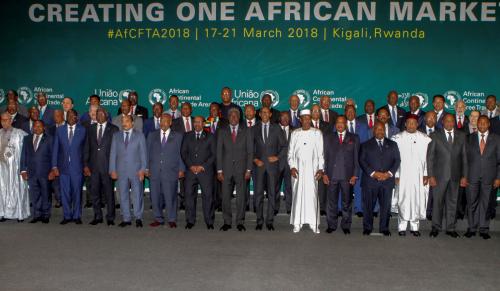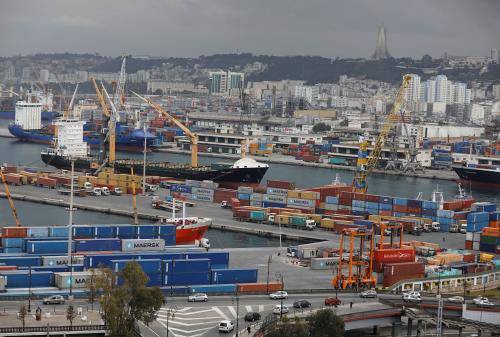Now that the African Continental Free Trade Area (AfCFTA) has come into force (see also our Brookings policy brief on the keys to success for the AfCFTA negotiations), policymakers and the business community should prioritize, develop, and implement smarter local strategies to seize the rising opportunities in manufacturing and industrialization across a variety of sectors and increase the global competitiveness of the continent. Right now, only 10 African countries (Mauritius, South Africa, Seychelles, Morocco, Tunisia, Botswana, Algeria, Kenya, Egypt, and Namibia) are ranked among the top 100 most competitive countries in world, per the 2018 Global Competitiveness Index. Given that an integrated continent will have a larger supply market, decreased trade restrictions, and free movement of people, manufacturing specialization will accelerate and make Africa’s industrialization globally competitive. As we have noted before, if the AfCFTA is successfully implemented, Africa’s manufacturing sector is projected to double in size with annual output increasing to $1 trillion by 2025 and create over 14 million jobs. Notably, one of the key objectives of the AfCFTA is to “enhance competitiveness at the industry and enterprise level through exploiting opportunities for scale production, continental market access and better reallocation of resources.”
One pathway to success will be effective AfCFTA implementation and better national ownership and alignment with Agenda 2063, the African Union’s strategic framework for the socio-economic transformation of the continent. Agenda 2063 aims at creating a “strong, united, and influential global player and partner,” turning African countries into the best performers in global quality of life measures and accelerating inclusive growth, including through industrialization, import substitution, and employment. Unsurprisingly, manufacturing and industry—fundamental for overall economic growth and poverty alleviation—feature prominently. A robust manufacturing industry can provide well-paid jobs for large numbers of low-skilled workers, increase average household incomes, boost domestic demand, stabilize economies against external shocks, and contribute to innovation and diversification.
The AfCFTA and Agenda 2063 hope to reverse Africa’s premature deindustrialization and tap into the vast number of manufacturing opportunities that persist, including in software, auto components, industrial and business machinery, chemicals, agro-processing, and clothing and footwear subsectors, among others. Indeed, some countries already claim advantages in certain subsectors. One example is Kenya, whose relatively strong industrial manufacturing sector accounts for nearly 20 percent of the country’s economic activity and 12.5 percent of all formal jobs, and which has become the primary supplier of motor vehicles for East African markets.
National efforts toward a globally competitive industrialization
Already, in countries such as Cameroon, Egypt, Kenya, Morocco, Nigeria, Senegal, and South Africa, business-to-business spending is a major contributor to growth, and these countries are beginning to implement policies to capitalize on this opportunity. Increased business-to-business spending will also improve African firms’ ability to specialize—an essential determinant of growth in manufacturing—as necessary inputs can be sourced from other businesses or neighboring markets, rather than produced in-house. The projected increase in Africa’s business-to-business spending in manufacturing by $200 billion to a total of $666.3 billion by 2030 presents further opportunities to advance manufacturing for the continent given the free trade area. In fact, manufacturing goods constitute a higher percentage of intra-African exports, compared to extra-African ones (41.9 percent compared to 14.8 percent in 2014). The business-to-business market is made up of thousands of firms, many of them smaller businesses, with substantial demand for materials, goods, and services across a wide range of sectors.
Several African countries have made substantial progress in implementing industrial policies, even if more can be done: South Africa’s Industrial Policy Action Plan, which coordinates ministries and policy areas and prioritizes industrialization over trade and other economic goals, has supported the country’s manufacturing growth by attracting investment and boosting industrialization. In Morocco, the government has incentivized a shift within the manufacturing sector toward automotive assembly—a lucrative market—by offering fiscal and tax incentives in some free zones. Finally, Zambia offers benefits within its six pilot multi-facility economic zones around the capital, Lusaka, where VAT payments on inputs are eliminated and corporate tax payments are reduced or deferred. This pilot project has already attracted $120 million in investment from different companies. Even if the ultimate responsibility for industrial development lies with national governments that should reduce the cost of doing business, improve industrial infrastructure, and invest in human capital, among other factors, the AfCFTA offers a unique opportunity to increase competitiveness and scale production for a single continental market.
Overall, the stereotypical narrative that African countries are limited to producing and trading goods for external markets is not representative of the continent’s improving supply and demand statistics. Policymakers should now identify the gaps in their national agendas and implement policies that benefit local production and offer enticing opportunities to foreign investment. Investors, on the other hand, should consider where manufacturing inputs can be sourced locally to reduce costs related to transport, import tariffs, and exchange rate fluctuations.
Africa has many of the necessary resources to build its manufacturing potential, and successful integration will make the African continent the primary beneficiary of its industrial development. While African countries move toward continent-wide integration, “The potential of manufacturing and industrialization in Africa: Trends, opportunities, and strategies” offers concrete recommendations for policymakers and investors to make Africa a globally competitive manufacturing powerhouse.
Note: This blog reflects the views of the authors only and does not reflect the views of the Africa Growth Initiative.









Commentary
Africa’s industrialization under the Continental Free Trade Area: Local strategies for global competitiveness
June 4, 2019